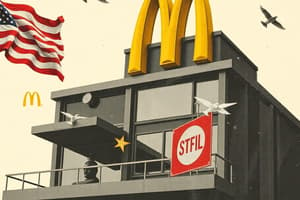Podcast
Questions and Answers
Which of the following is NOT a factor considered by social epidemiology when examining health disparities?
Which of the following is NOT a factor considered by social epidemiology when examining health disparities?
- Religious Affiliation (correct)
- Income Distribution
- Race
- Gender
What is the primary focus of the 'illness experience' concept within sociology?
What is the primary focus of the 'illness experience' concept within sociology?
- The effectiveness of different medical treatments for various illnesses
- The biological mechanisms underlying disease progression
- The historical development of medical knowledge and practices
- The emotional and social impact of illness on individuals (correct)
What is the main critique of the current healthcare system, according to the text?
What is the main critique of the current healthcare system, according to the text?
- The healthcare system is too slow to adapt to new medical discoveries and treatments
- The healthcare system is too heavily reliant on technology and not enough on human interaction
- The healthcare system is too focused on individual behavior and ignores societal factors affecting health
- Lack of access to preventative care leads to higher healthcare costs in the long run (correct)
What is the defining characteristic of medicalization?
What is the defining characteristic of medicalization?
The concept of the 'sick role' suggests that individuals who are ill are expected to:
The concept of the 'sick role' suggests that individuals who are ill are expected to:
What is the main idea behind the 'functionalist' perspective on society?
What is the main idea behind the 'functionalist' perspective on society?
Which of the following best exemplifies the concept of a 'social fact' according to the text?
Which of the following best exemplifies the concept of a 'social fact' according to the text?
What is the primary focus of the 'delivery of healthcare' concept, as discussed in the text?
What is the primary focus of the 'delivery of healthcare' concept, as discussed in the text?
What is one potential negative consequence of the division of labor in an ideal bureaucracy?
What is one potential negative consequence of the division of labor in an ideal bureaucracy?
Which characteristic of an ideal bureaucracy allows for the clear understanding of authority?
Which characteristic of an ideal bureaucracy allows for the clear understanding of authority?
What is a disadvantage of employing strict written rules and regulations in an organization?
What is a disadvantage of employing strict written rules and regulations in an organization?
What can be a consequence of impersonality in bureaucratic settings?
What can be a consequence of impersonality in bureaucratic settings?
How does employment based on technical qualifications benefit organizations?
How does employment based on technical qualifications benefit organizations?
What phenomenon describes the tendency for employees to be promoted until they reach their level of incompetence?
What phenomenon describes the tendency for employees to be promoted until they reach their level of incompetence?
What is one of the core principles of McDonaldization that has influenced other sectors beyond fast food?
What is one of the core principles of McDonaldization that has influenced other sectors beyond fast food?
Which of the following is NOT a pro of having a hierarchy in an organization?
Which of the following is NOT a pro of having a hierarchy in an organization?
What is the primary factor influencing foraging behavior in animals?
What is the primary factor influencing foraging behavior in animals?
Which foraging strategy allows animals to take down larger prey?
Which foraging strategy allows animals to take down larger prey?
What is a primary benefit of random mating in a population?
What is a primary benefit of random mating in a population?
What is the potential downside of assortative mating?
What is the potential downside of assortative mating?
What mating strategy is characterized by individuals with diverse traits mating more frequently?
What mating strategy is characterized by individuals with diverse traits mating more frequently?
Inclusive fitness takes into account which of the following?
Inclusive fitness takes into account which of the following?
What does evolutionary game theory suggest about survival and reproduction?
What does evolutionary game theory suggest about survival and reproduction?
Which of the following best describes mating behavior?
Which of the following best describes mating behavior?
What aspect does macrosociology primarily focus on?
What aspect does macrosociology primarily focus on?
How does evolutionary game theory differ from classical game theory?
How does evolutionary game theory differ from classical game theory?
Which theory in macrosociology emphasizes the stability of societal institutions?
Which theory in macrosociology emphasizes the stability of societal institutions?
What do social institutions do within society?
What do social institutions do within society?
Which of the following best describes microsociology?
Which of the following best describes microsociology?
What does conflict theory suggest about societal institutions?
What does conflict theory suggest about societal institutions?
What is intention reasoning in the context of game theory?
What is intention reasoning in the context of game theory?
Which of the following examples aligns with symbolic interactionism?
Which of the following examples aligns with symbolic interactionism?
What is meant by the term 'hidden curriculum' in the context of education?
What is meant by the term 'hidden curriculum' in the context of education?
How does educational segregation occur?
How does educational segregation occur?
What is the primary emphasis of nuclear families in urban settings?
What is the primary emphasis of nuclear families in urban settings?
What impact do teacher expectations have on student learning?
What impact do teacher expectations have on student learning?
Which of the following describes the common structure of family in contemporary society?
Which of the following describes the common structure of family in contemporary society?
Why can categorization of students by teachers be problematic?
Why can categorization of students by teachers be problematic?
What is a common reason for divorce in modern society?
What is a common reason for divorce in modern society?
What kinds of abuse can occur within a family structure?
What kinds of abuse can occur within a family structure?
What characterizes a cult compared to other religious organizations?
What characterizes a cult compared to other religious organizations?
Which form of government is characterized by the concentration of power in a single ruler?
Which form of government is characterized by the concentration of power in a single ruler?
What is a key trait of capitalism?
What is a key trait of capitalism?
What does secularization refer to in the context of religion?
What does secularization refer to in the context of religion?
Which social structure is typically formed in response to dissatisfaction with an established church?
Which social structure is typically formed in response to dissatisfaction with an established church?
In which system does ownership of all property exist collectively within the community?
In which system does ownership of all property exist collectively within the community?
What does fundamentalism propose in reaction to secularization?
What does fundamentalism propose in reaction to secularization?
What aspect of labor division does functionalism highlight?
What aspect of labor division does functionalism highlight?
Flashcards
Foraging
Foraging
The process by which animals find and consume food.
Solitary Foraging
Solitary Foraging
A foraging strategy where animals hunt and gather food alone.
Group Foraging
Group Foraging
A foraging strategy where animals hunt and gather food together.
Mating
Mating
Signup and view all the flashcards
Random Mating
Random Mating
Signup and view all the flashcards
Assortative Mating
Assortative Mating
Signup and view all the flashcards
Disassortative Mating
Disassortative Mating
Signup and view all the flashcards
Inclusive Fitness
Inclusive Fitness
Signup and view all the flashcards
McDonaldization
McDonaldization
Signup and view all the flashcards
Ideal Bureaucracy
Ideal Bureaucracy
Signup and view all the flashcards
Division of Labour
Division of Labour
Signup and view all the flashcards
Hierarchy of Organization
Hierarchy of Organization
Signup and view all the flashcards
Written Rules and Regulations
Written Rules and Regulations
Signup and view all the flashcards
Impersonality
Impersonality
Signup and view all the flashcards
Technical Qualifications for Hiring
Technical Qualifications for Hiring
Signup and view all the flashcards
The Peter Principle
The Peter Principle
Signup and view all the flashcards
Game Theory
Game Theory
Signup and view all the flashcards
Selfish Group
Selfish Group
Signup and view all the flashcards
Non-Selfish Group
Non-Selfish Group
Signup and view all the flashcards
Macrosociology
Macrosociology
Signup and view all the flashcards
Microsociology
Microsociology
Signup and view all the flashcards
Functionalism
Functionalism
Signup and view all the flashcards
Conflict Theory
Conflict Theory
Signup and view all the flashcards
Symbolic Interactionism
Symbolic Interactionism
Signup and view all the flashcards
What is an ecclesia?
What is an ecclesia?
Signup and view all the flashcards
What are churches?
What are churches?
Signup and view all the flashcards
What are sects?
What are sects?
Signup and view all the flashcards
What are cults?
What are cults?
Signup and view all the flashcards
What is secularization?
What is secularization?
Signup and view all the flashcards
What is fundamentalism?
What is fundamentalism?
Signup and view all the flashcards
What is a monarchy?
What is a monarchy?
Signup and view all the flashcards
What is a democracy?
What is a democracy?
Signup and view all the flashcards
Social Institutions
Social Institutions
Signup and view all the flashcards
Hidden Curriculum
Hidden Curriculum
Signup and view all the flashcards
Educational Segregation
Educational Segregation
Signup and view all the flashcards
Family
Family
Signup and view all the flashcards
Marriage
Marriage
Signup and view all the flashcards
Divorce
Divorce
Signup and view all the flashcards
Child Neglect
Child Neglect
Signup and view all the flashcards
Elder Abuse
Elder Abuse
Signup and view all the flashcards
Large-scale perspective
Large-scale perspective
Signup and view all the flashcards
Social facts
Social facts
Signup and view all the flashcards
Institutions
Institutions
Signup and view all the flashcards
Medicalization
Medicalization
Signup and view all the flashcards
Sick role
Sick role
Signup and view all the flashcards
Delivery of healthcare
Delivery of healthcare
Signup and view all the flashcards
Social epidemiology
Social epidemiology
Signup and view all the flashcards
Study Notes
McDonaldization
- Fast-food organizations influence other sectors
- Key principles: efficiency, calculability, predictability, and control
- These principles affect various areas like medicine, entertainment, and more
Max Weber's Ideal Bureaucracy
- Sociologist Max Weber studied organizational structures.
- 5 key characteristics:
- Division of labor: workers specialized in specific tasks (pros: increased efficiency, cons: alienation)
- Hierarchy of organization: clear chain of command (pros: clarity in who's in charge, cons: stifling of voices, cover-up)
- Written rules and regulations: clear expectations and uniform performance, (pros: clear expectations, equal treatment cons: decreased creativity, initiative stifling)
- Impersonality: impartial treatment of individuals and goal-driven (pros: equal treatment, cons: diminished loyalty and individuality)
- Employment based on technical qualifications: hiring based on merit, not on favoritism (pros: decrease discrimination and bias, cons: lack of diversity)
Animal Communication
- Humans communicate with language and non-verbal cues.
- Animals use various cues, including visual, vocal, and chemical signals, to communicate
- Animals communicate with members of their own species or other species.
- Different types of animal communication: auditory (sound), chemical (pheromones), tactile (touch), visual, seismic(earthquakes).
Animal Behavior: Foraging
- Foraging is the search for food.
- Animals weigh costs and benefits of foraging. Food can be scarce.
- Two types of foraging strategies:
- Solitary foraging
- Group foraging (potentially enhances opportunities to target larger prey)
Mating Behavior
- Mating involves pairing and the process of reproduction.
- Strategies include:
- Random mating: equal chance of mating with any individual
- Assortative mating: individuals with similar characteristics mate more frequently (can increase genetic similarity)
- Disassortative mating occurs when individuals with diverse traits mate more frequently.
Inclusive Fitness
- Animals prioritize the survival and reproduction of family members.
- Passing on genes influences fitness, and behaviors.
Evolutionary Game Theory
- Understanding decision-making and behavior through evolutionary context.
- Animal behaviors related to reproduction, strategy, and resources.
Society and Social Structures
- Macrosociology: large-scale social trends (e.g., poverty, war).
- Microsociology: small-scale social interactions (e.g., doctor-patient interactions).
- Symbolic interactionism: how people give meaning to symbols.
- Social institutions: major entities like schools, religion, or government, that impact people.
Social Institutions (Education, Family, Religion, Government, Economy)
- Education, Family, Religion, Government, and Economy are essential social institutions.
- Institutions influence individuals and society's evolution.
Healthcare and Medicine
- Medicalization: Normal human conditions become medical issues.
- The "sick role": societal expectations regarding being sick.
- Delivery of healthcare: variations in access.
- Social factors influences health status, social classes, etc.
Social Facts
- Societal norms and values that are external to individuals.
- These exert a coercive effect on individuals over time.
- Manifest functions: intended consequences of social institutions
- Latent functions: unintended consequences of social institutions.
- Social dysfunction: an aspect of society that creates issues, with a negative impact and reduce stability of society.
Studying That Suits You
Use AI to generate personalized quizzes and flashcards to suit your learning preferences.
Related Documents
Description
Explore the impact of McDonaldization on various sectors and how it aligns with Max Weber's ideal bureaucracy concepts. This quiz delves into efficiency, calculability, and the key characteristics of organizational structure, presenting a nuanced view of modern influences and challenges.





